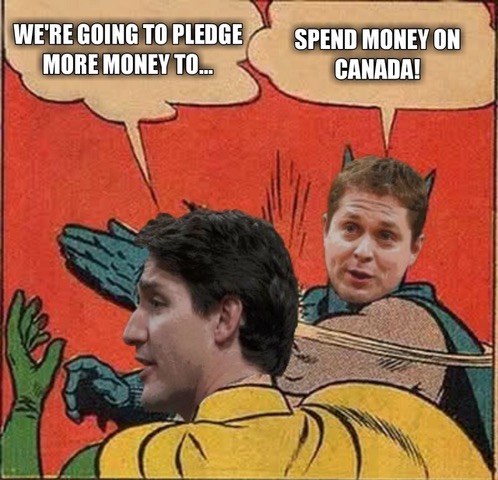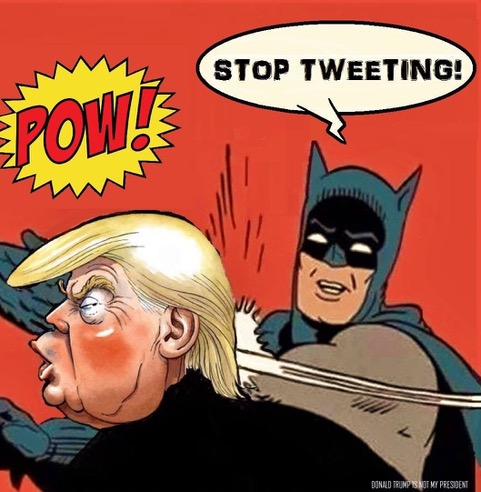By Wendy Chou

About and origin
Why would Batman ever hit his favourite sidekick Robin? The panel originated from the 1965 comic book “World’s Finest #153” – an “Imaginary Story” of DC comics. The story is set in an alternative reality where Batman believes that Superboy and Superman are responsible for the death of his father.[1] The panel here depicts the aftermath of Robin’s failed attempt to stop Batman from pursuing Superman.
Here, the ‘always-saving-the-world’ Batman is labelled as Andrew Scheer, leader of the Conservative Party, while his junior counterpart, Robin, is labelled as Prime Minister Justin Trudeau. When Trudeau announces his plans to pledge more money, Scheer interrupts him by saying “Spend money on Canada!” The meme insinuates that Scheer is the one who truly devotes himself to Canadian people, presenting him to audiences as the better candidate compared to Trudeau.
Context and circulation
The meme was collected from the Facebook page Justin Trudno – a “Satire page for Canadian Prime Minister Justin Trudeau”.[2] Focusing on delegitimizing the Liberal party and particularly its current leader, the group usually covers issues and scandals surrounding Trudeau.
The meme takes up the issue of the Trudeau government’s spending practices, which allegedly amount to wasting money abroad.[3] However, the meme does not mention any specific incident. Akin to most posts on Justin Trudno, the meme criticizes Trudeau’s overall character and qualities as a leader rather than specific policies. Therefore, it can be assumed that the goal of the meme is to reinforce previously held attitudes toward Trudeau in the group members’ minds. More specifically, it presumably serves to remind the audience of Trudeau’s $10.5 million payment to Omar Khadr[4] – an event that was constantly brought up in the page.
Analysis
The meme has two purposes: to degrade the opponent political party and to strengthen the strong ideological group identity of conservative voters.
Even if only looking at the visual elements of the original panel, the context of the narrative is already clearly illustrated – Batman, a heroic vigilante who saves Gotham City, striking his junior sidekick, Robin. However, seeing the image without having read the ‘Imaginary Story’ of DC comics first, one can only assume that it is either Robin’s incompetence that leads to the outcome or that Robin has simply done wrong in the situation.
The meme directly taps into the existing popular cultural knowledge within the audience, allowing them to associate Scheer with righteousness and Trudeau with inadequacy. This idea then becomes even more apparent when the text is added into the image. Trudeau, the meme infers, wastes taxpayers’ dollars instead of spending them “on Canada”. Scheer, as he slaps Trudeau, stands up for all Canadians to right a wrong. Although the meme does not state directly that one should vote for the Conservative Party, it does suggest that Scheer is the candidate who can be better trusted.
Scheer would never hit Trudeau or cut him off mid-sentence during the campaign. Yet, in an alternative reality in a comic book, anything is possible. Through the graphic storytelling, the meme dramatizes the party’s different platforms, adding comic book flare to Scheer’s promise to cut foreign spending. By labelling Scheer as the Batman character striking and scolding Trudeau, it enables the viewers to imagine Scheer to be the one in authority. Not just a joke, the meme transports viewers to “a particular spatial, emotional, and virtual space” where Scheer is the heroic leader of Canada[5].
On the emotional level, the meme cleverly taps into nationalist sentiments. In a political context, patriotism or national pride are arguably the most powerful emotions that a campaign can elicit. The meme insinuates that Trudeau has been giving money to outside of Canada. It is likely that it would stir negative emotions in conservative Canadian viewers, based on the sentiment that ‘Canadians should come first’. In this case, ‘Canadianness’ becomes an identifier that directs the audience to interpret the meme and the campaign as a fight between Canadians protecting their own interests and traitors.
The ambiguity and image-building functions of the meme allow it to construct a positive image of Scheer and a negative image of Trudeau without needing to say much. Through the coupling of the visual elements and very little text, the meme is simple, yet effective.
References
[1] “My Parents Are Dead / Batman Slapping Robin,” Know Your Meme, November 26, 2019, https://knowyourmeme.com/memes/my-parents-are-dead-batman-slapping-robin.
[2] “Justin Trudno,” Facebook. Accessed January 12, 2020. https://www.facebook.com/pg/JustinTrudeauNope/about/.
[3] Wright, Teresa, and Canadian Press. “Baloney Meter: Andrew Scheer Says Canada Sends Foreign Aid to Rich Countries.” National Post, October 2, 2019. https://nationalpost.com/pmn/news-pmn/canada-news-pmn/baloney-meter-andrew-scheer-says-canada-sends-foreign-aid-to-rich-countries.
[4] Waldie, Paul. “Trudeau defends apology and $10.5-million payment to Omar Khadr.” Globe and Mail, July 8, 2017. https://www.theglobeandmail.com/news/national/trudeau-defends-apology-and-105-million-payment-to-omar-khadr/article35623594/
[5] Dan Schill, “The Visual Image and the Political Image: A Review of Visual Communication Research in the Field of Political Communication,” Review of Communication 12, no. 2. (2012): 131.




